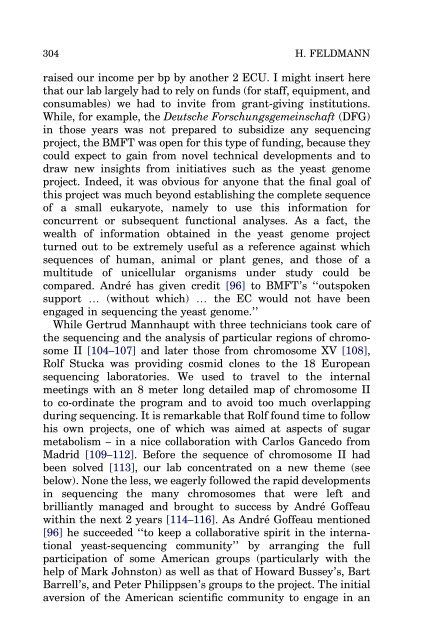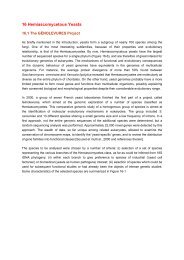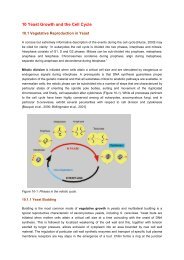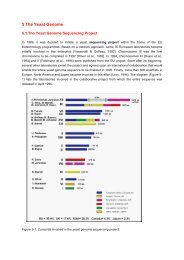A Life with Yeast Molecular Biology - Prof. Dr. Horst Feldmann
A Life with Yeast Molecular Biology - Prof. Dr. Horst Feldmann
A Life with Yeast Molecular Biology - Prof. Dr. Horst Feldmann
Create successful ePaper yourself
Turn your PDF publications into a flip-book with our unique Google optimized e-Paper software.
304<br />
H. FELDMANN<br />
raised our income per bp by another 2 ECU. I might insert here<br />
that our lab largely had to rely on funds (for staff, equipment, and<br />
consumables) we had to invite from grant-giving institutions.<br />
While, for example, the Deutsche Forschungsgemeinschaft (DFG)<br />
in those years was not prepared to subsidize any sequencing<br />
project, the BMFT was open for this type of funding, because they<br />
could expect to gain from novel technical developments and to<br />
draw new insights from initiatives such as the yeast genome<br />
project. Indeed, it was obvious for anyone that the final goal of<br />
this project was much beyond establishing the complete sequence<br />
of a small eukaryote, namely to use this information for<br />
concurrent or subsequent functional analyses. As a fact, the<br />
wealth of information obtained in the yeast genome project<br />
turned out to be extremely useful as a reference against which<br />
sequences of human, animal or plant genes, and those of a<br />
multitude of unicellular organisms under study could be<br />
compared. André has given credit [96] to BMFT’s ‘‘outspoken<br />
support y (<strong>with</strong>out which) y the EC would not have been<br />
engaged in sequencing the yeast genome.’’<br />
While Gertrud Mannhaupt <strong>with</strong> three technicians took care of<br />
the sequencing and the analysis of particular regions of chromosome<br />
II [104–107] and later those from chromosome XV [108],<br />
Rolf Stucka was providing cosmid clones to the 18 European<br />
sequencing laboratories. We used to travel to the internal<br />
meetings <strong>with</strong> an 8 meter long detailed map of chromosome II<br />
to co-ordinate the program and to avoid too much overlapping<br />
during sequencing. It is remarkable that Rolf found time to follow<br />
his own projects, one of which was aimed at aspects of sugar<br />
metabolism – in a nice collaboration <strong>with</strong> Carlos Gancedo from<br />
Madrid [109–112]. Before the sequence of chromosome II had<br />
been solved [113], our lab concentrated on a new theme (see<br />
below). None the less, we eagerly followed the rapid developments<br />
in sequencing the many chromosomes that were left and<br />
brilliantly managed and brought to success by André Goffeau<br />
<strong>with</strong>in the next 2 years [114–116]. As André Goffeau mentioned<br />
[96] he succeeded ‘‘to keep a collaborative spirit in the international<br />
yeast-sequencing community’’ by arranging the full<br />
participation of some American groups (particularly <strong>with</strong> the<br />
help of Mark Johnston) as well as that of Howard Bussey’s, Bart<br />
Barrell’s, and Peter Philippsen’s groups to the project. The initial<br />
aversion of the American scientific community to engage in an







